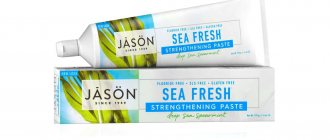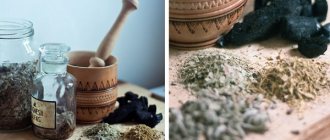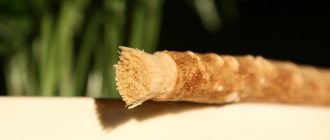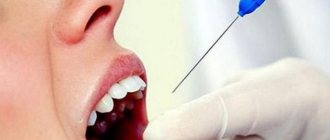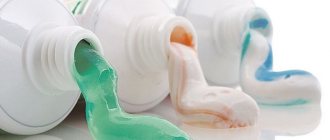Strong and beautiful teeth are every person’s dream. That is why special attention should be paid to proper oral hygiene. Toothpaste is an integral part of daily dental and gum care. It can not only maintain oral health, but also reduce the manifestations of various dental diseases. You will learn how to choose the right toothpaste in this article.
Tip No. 1: calculate harmful components
Only a few of us have received medical education and have an idea of what is “mixed” into our daily oral and body care products. This applies not only to toothpastes, but also to the entire arsenal of drugs (shampoos, creams, etc.). But you always need to strive for perfection, and if you don’t at least know thoroughly all the nuances of production, then have an idea about them.
The content of harmful substances should be kept to a minimum
A good toothpaste should effectively remove food debris and fight various types of bacteria. It is also good if it helps to normalize the balance of microflora in the oral cavity, strengthen enamel, create conditions for the prevention of caries and gum disease, get rid of unpleasant odors and give fresh breath.
To provide all these positive properties, manufacturers add various active ingredients to the composition. But they must be as safe as possible, natural, and contain a minimum of harmful substances:
- lauryl sulfate and propylene glycol (PEG): components are almost irreplaceable in any hygiene product, as they contribute to the formation of thick foam and the destruction of dirt. But in large dosages they cause allergies, manifested by unbearable itching. They can also provoke inflammation of the gums and periodontal tissues (periodontitis and periodontal disease). In addition, the substances are extremely toxic, dry out the mucous membranes, and are hazardous to health,
Periodontitis and periodontal disease - parabens: the best toothpaste should not be stored for more than 12 months from the date of production (and this is the maximum). Otherwise, it contains a lot of parabens. These substances increase its shelf life, but are not excreted, but accumulate in the body and even provoke the development of cancerous tumors,
- triclosan, metronidazole: these are antibiotics and their use is justified only in the presence of acute inflammatory processes in the mouth. However, such components are often included in regular pastes and therefore many do not even suspect that their use should only be carried out under the strict supervision of the attending physician. As a last resort, you can use pastes in courses, no longer than one month in a row. Otherwise, you risk getting complications in your internal organs. For example, on the lungs, kidneys, liver. And there is also a risk of “exterminating” not only all harmful, but also beneficial microflora in the mouth.
On a note!
Sodium lauryl sulfate, for example, contains most of the well-known and advertised pastes, such as Blend-a-med, Colgate, Oral-B, Forest Balsam, New Pearl.
What's most important about pasta?
It is worth noting that it is not so much the toothpaste that is important, but the brushing itself – thorough and regular.
Everyone knows that after eating, especially those containing sugar, plaque forms on the tooth enamel. It contains acids that over time corrode the enamel, causing pores to appear in it, into which microbes rush. As a result, caries forms. Therefore, first of all, the paste must remove plaque well and neutralize these acids. A sign of a paste that removes plaque well is its ability to foam profusely. – Sodium lauryl sulfate (SLS) provides rich foam and a squeaky clean teeth feeling, but it is believed that it may be harmful to health, although there is no conclusive evidence of its harm. On many pastes, the fact that they do not contain this compound is indicated as a plus. Sodium bicarbonate is also good at destroying plaque, which has a salty taste and increases salivation, which promotes self-cleaning of teeth, and also neutralizes the acidic environment for a long time, explains Marina Kuznetsova.
Tip #2: pay attention to abrasives
Everyone knows that without abrasives, an adult paste will simply be inferior, because then it will not be able to cope with the plaque that forms on our teeth every day. By the way, on packages this indicator is usually indicated by the abbreviation RDA.
Please also note that the abrasives in toothpastes are different:
- calcium carbonate: the most common. These are quite large particles, they roughly remove plaque, but in no way have a remineralizing and restorative effect on the enamel,
- Aluminum oxide: the drug is prohibited in the European Union and the USA due to its harmfulness. It often leads to the formation of inflammation and ulcers in the mouth due to its aggressive component. It has also been proven that high levels of this substance in the body enhance skeletal abnormalities, disrupt the metabolism of phosphorus and calcium, slow down metabolism, cause osteoporosis of the bone structure,
- silicon oxide: the most preferred composition, it is finely dispersed and does not have a negative effect on the enamel.
Children should use children's toothpaste.
Another tip: never use the same toothpaste for all family members. It is not suitable for children, because the adult composition can be harmful to children’s fragile enamel; people with sensitive teeth should also be careful. The permissible number of abrasives for children is 20-30 RDA. For adults with healthy teeth - up to 100 RDA, for sensitive enamel - no more than 60. For smokers and those who want to whiten their shade - 120-150 RDA. The same paste cannot provide the same effect to everyone.
Toothpaste and braces
When installing braces, you need to be more careful when choosing toothpaste. After all, the non-removable structure creates additional difficulties when brushing your teeth. In addition, while wearing braces, it is necessary to abandon whitening toothpastes so that after removing the corrective devices, the teeth are the same color. Dentists advise changing toothpastes at certain stages of teeth correction. For example, in the first months after installing braces, calcium is actively lost from the teeth, so pastes with a high content of this substance are needed. Then it is important to eliminate possible risks of caries, so strengthening toothpastes are suitable. At the final stages of wearing braces, doctors recommend switching to anti-inflammatory pastes to prepare the patient for painless removal of corrective systems. When choosing, you need to pay attention to the brands of those companies that specialize in producing toothpastes for braces, and consult with the treating orthodontist.
Examples of toothpastes for braces:
- ROCS PRO Brackets & Ortho.
- Gum Ortho.
- Dentaid Vitis Orthodontic.
Tip #3: Fluoride is not always beneficial
Some people mistakenly believe that which toothpaste is better can be determined by the high fluoride content in its composition. Indeed, the element is extremely important, since without it, proper calcium metabolism in the body is simply impossible. In addition, it helps strengthen the enamel, and recent studies have proven that the component reduces the risk of developing caries by 30-40%.
However, fluorine is toxic and is completely unsuitable for those who live in regions where the water and soil are saturated with it - the Moscow region, Nizhny Novgorod, Sverdlovsk, Tver, Tomsk regions. The microelement, or rather its excess, can provoke various diseases and cause extremely unattractive fluorosis on the teeth.
The photo shows dental fluorosis
As for the concentration, it should not exceed 1500 ppm in pastes for adults, and 500 for school-age children. For children under 5-6 years old, it is better to exclude this component altogether, because it is quite toxic if swallowed.
Rules for choosing pasta
It is difficult to meet a person whose teeth are completely healthy. Even if there is no periodontal disease, caries or other diseases, tooth enamel may be destroyed and may lack calcium, fluoride or other components. If you abuse bad habits or drink coffee frequently, your teeth acquire a different color and are constantly in need of prevention.
When choosing toothpaste, you should listen to the opinions of dentists
It is best to consult your dentist about choosing the right toothpaste. If the product is purchased correctly, it will quickly get rid of plaque and prevent the appearance of tartar, caries and other diseases.
There are several types of toothpaste, it all depends on what effect it should have on the oral cavity:
- For sensitive teeth, cleaning should be high-quality and gentle; natural protection should not be damaged. Due to the destruction of enamel, dentin is exposed, and in the future the tooth may be destroyed. It can only be protected by placing a filling or applying fluoride. The paste is needed in the future in order to provide good protection. For especially sensitive teeth, you should choose a toothpaste that contains potassium salts and strontium chloride, which make tooth enamel stronger. Dentists advise paying attention to the packaging of the paste; the RDA index should be at least 75.
- Darkened teeth require toothpastes with a whitening effect, but they can only be used if the enamel is strong. The frequency of using such products is a maximum of three times a week, otherwise in just a few months the enamel will begin to deteriorate. The abrasiveness index in such pastes should be above two hundred. Dark enamel will become lighter, but naturally you should not expect a snow-white effect. A manufacturer who claims such a result is just advertising his product; in reality, this cannot happen. Remember, if whitening pastes contain chalk, this will cause destruction of the neck of the tooth.
- Antiseptic pastes. Perhaps everyone knows that the oral cavity contains the largest number of bacteria. It is important to regularly cleanse your mouth of them, otherwise your teeth will begin to decay.
- Anticarious - they should contain sodium fluoride, amino fluorides, calcium glycerophosphate. The amount of fluoride should not be large, because it is already in the water, and if there is an excess, nothing but harm can be expected. If there is not enough calcium, you should give preference to those pastes that contain calcium glycerophosphate; over time, it will not wash off from the enamel.
- Children's pastes - the requirements for this category of pastes are special. This is exactly the case when you cannot trust only one package. The components in the composition should be gentle, avoid silicon dioxide and dicalcium phosphate. The index should not exceed fifty.
When choosing a toothpaste, you should carefully study its composition.
As mentioned above, there are also pastes that are recommended for smokers and coffee lovers. They are directly similar to bleaching agents, but as an addition they provide a refreshing effect.
Why do teeth become sensitive?
Many people complain that their teeth become extremely sensitive, but not everyone knows what is causing this.
Most often, the person himself provokes such problems:
- failure to comply with the rules of personal hygiene in the oral cavity;
- poor nutrition;
- frequent consumption of coffee;
- abuse of bad habits;
- use of low-quality toothpastes.
Due to the thinning of tooth enamel, teeth become extremely vulnerable; when eating hot or cold food with liquid, a person feels severe discomfort.
Numerous problems arise from thinning tooth enamel
In order to avoid such sensations, you should adhere to simple rules, which include the following:
- Regular sanitation of the oral cavity. Movements when brushing your teeth should be soft and smooth; it is forbidden to put pressure on the toothbrush.
- You should choose the right paste and brush. The product should not contain aggressive bleaching components or other aggressive substances. The hardness of the brush should be medium.
- Drink as much fluid as possible. In addition, you should eat cottage cheese, milk and cheese. Avoid combining hot and cold drinks, otherwise your tooth enamel will begin to erode.
In order to never experience toothache and maintain your health for a long time, you need to take a responsible approach to oral hygiene.
Tip #4: use the paste according to the situation
It is quite difficult to answer unequivocally the question of which toothpaste is best to use. After all, everyone is looking for exactly what suits them. For example, one person needs to whiten enamel at a given time. For gentle whitening, there are worthy representatives with a high content of abrasive substances that will effectively solve the problem of yellow enamel even in smokers. Among the leaders approved by experts were Colgate and Silca, which really give a brightening effect.
For each problem, select the appropriate paste
However, their composition is completely unsuitable for people with hypersensitive teeth who need to strengthen the enamel. The drug will also harm those who are trying to stop the development of gingivitis and get rid of bleeding gums.
If you are trying to whiten your teeth at home using toothpastes, then remember: no home whitening will be as effective as a procedure in the dental chair. As for safety, keep in mind that hydrogen peroxide and abrasives (both in pastes and in natural products: coal, soda, salt, lemon) in excessive quantities have a traumatic effect on the enamel, as a result of which it becomes thinner and becomes sensitive to temperature changes , to attack by bacteria. And enamel that has undergone such whitening requires remineralizing procedures.
Different pastes are suitable for different purposes. But remember that you cannot become attached to any one brand for a long time, even if it is the best toothpaste for you: change it once every three months so as not to become addictive. As for whitening and medicinal pastes, try to use them only after consultation with your dentist and for no longer than three weeks in a row.
The best toothpaste manufacturers - which company to choose
Before purchasing, you should determine the manufacturer of the product. It is better to give preference to well-known companies that have been producing products that are in demand in many countries around the world for decades.
Such companies include:
1. Blend-a-Med;
2. Aquafresh;
3. Lacalut.
These brands produce a wide range of oral hygiene products. Their successful activity is due to the high quality of their products, which is achieved through strict production control, the use of the latest technological equipment, the best raw materials and cooperation with leading dentists.
To choose a quality teeth cleaning product, read our rating of the best toothpastes.
Recommendations: 10 best medicated toothpastes
12 Best Oral Irrigators
18 best toothpastes
Tip #5: shop at the pharmacy
No one is safe from buying a fake, but the risk of getting a low-quality product increases significantly if you do it in markets or in underground passages, or purchase goods from distributors.
It is better to buy toothpaste at a pharmacy
It is better to contact pharmacy chains, because they employ pharmacists and pharmacists who are directly responsible for the quality of the received product, its certification, expiration dates and storage conditions.
In relation to this point, it would be fair to mention which toothpaste is the best. This is the one that has the original composition declared by the real manufacturer, and complies with GOSTs and general technical conditions: 7983-99 and 29188.0. For example, like some of the drugs presented in the table below1.
| Index | Quality rating "excellent" | Quality rating "good" | Quality rating "satisfactory" |
| Color, aroma, consistency | Sensodyne, Splat, Lacalut sensitive for sensitive teeth and gums. | All pastes are Lacalut, Durodont 5, Dent & Healsh, Biocon. | Products from the brands “Forest Balsam”, “New Pearl”, “Ftorodent”. |
| Acidity of the composition and its effect on teeth | Sensodyne, Splat, Biotene, Durodont 5, Dent & Health, Biocon. | Lacalut, Forest Balsam, Pearl, New Pearl. | "Lesnaya", "Ftorodent". |
Moreover, price is not at all an indicator of quality; a product may turn out to be good and at the same time cost mere trifles, or it may be expensive and not at all correspond to the declared characteristics.
Main components and classification of pastes
Good products should not only “be able” to clean, but also have a certain preventive and even therapeutic effect on the teeth. To achieve this effect, the composition includes certain active components:
Abrasive, responsible for removing plaque (silicon compounds, calcium carbonate, etc.).- Foaming agents that allow you to use the tube economically thanks to the abundant foam generated during cleaning and excellent cleaning properties. These include sodium lauryl sarcosinate, SLS and alizarin oil.
- Various flavors for fresh breath.
- Flavoring additives. Most often, mint, herbs, green tea and even pine nuts and even chocolate are used. High-quality children's toothpastes mainly include fruit additives.
- Binders are hydrocolloids, which make the mass homogeneous. There are both natural and synthetic (tragacanate, cellulose ethers, sodium alginate, etc.).
- Humidifying components to retain moisture in the paste (polyethylene glycol, glycerin, etc.).
- Preservatives necessary to protect the product during its storage and use from the ingress of microorganisms and their proliferation (sodium benzoate, methylparaben, etc.).
Tip No. 6: “homemade” formulations are quite suitable for the prevention of diseases of teeth and gums
According to statistics, consumer choice is influenced by the smell, color, packaging and taste of the product, but not by its quality characteristics. At the same time, no more than 10% of the formulations sold in stores can truly boast of the status of “environmentally friendly and healthy product.” Take, for example, the fact that preservatives are no longer necessary to store them.
Even toothpastes “rich” in minerals and natural plant extracts, which are quite good and tested by consumers, contain harmful substances to one degree or another. For example, Lacalut, Splat, President, ROCS. Therefore, some rightly believe that the best toothpaste is the one you make yourself.
Homemade toothpaste should always be fresh
For home care of teeth and gums, sage, chamomile, mint, tea tree oil, honey, and birch bark are suitable. According to reviews, users use them to cleanse the oral cavity in different compositions and concentrations; which toothpastes are better, everyone here determines for himself.
However, it is worth remembering one rule: good “homemade” toothpaste should always be fresh, and it should be prepared daily. Otherwise, you may not only not be beneficial, but also harm the body. And it’s not a fact that without adding abrasive particles you will be able to get rid of plaque.
According to the portal’s editors, this advice should not be abused. And homemade formulations are best used not as an independent element of care, but in combination with other daily hygiene products: toothpaste selected based on the condition of your teeth and gums together with the dentist, mouth rinse, irrigator and floss, and a properly selected toothbrush.
If you are still thinking about which toothpaste is best, then immediately go to see a dentist, he will examine your oral cavity and will definitely help you with advice.
Notice
: Undefined variable: post_id in
/home/c/ch75405/public_html/wp-content/themes/UltraSmile/single-item.php
on line
45 Notice
: Undefined variable: full in
/home/c/ch75405/public_html/wp-content /themes/UltraSmile/single-item.php
on line
46
Rate this article:
( 4 ratings, average: 5.00 out of 5)
prevention
- According to independent studies.
How often can you use whitening toothpastes?
There are two types of whitening pastes: abrasive and enzymatic. The former act through abrasive particles (here the emphasis is on mechanical action), and the latter through enzymes. In theory, the paste should indicate its abrasiveness index (RDA), but in Russia not all manufacturers follow this rule.
– If the abrasive paste says “whitening”, most likely the RDA is more than 100–120, which means there are a lot of abrasive particles. It’s like cleaning a surface with sandpaper, and it’s better to choose enzyme-based pastes,” explains Marina Kuznetsova. – For a long time I was skeptical about such pastes, but recently I came across a study that proves that there is no difference in effectiveness, but enzyme pastes do not harm the enamel, but simply dissolve tooth pigment.
Abrasives can be listed as phosphates (calcium pyrophosphate), carbonates (calcium carbonate), silicon compounds, aluminum compounds. Enzymes include, for example, papain or bromelain, as well as substances that prevent the formation of plaque and tartar: polydone and pyrophosphates.
“Whitening” occurs by removing pigmented plaque from tea, coffee and tobacco and returning the enamel to its natural shade, so if your teeth are naturally yellowish, only a professional procedure in a doctor’s office will give you a snow-white smile.
If you use abrasive pastes, the dentist advises doing this no more than once a week – and then only in the absence of tooth sensitivity.
Why do teeth become sensitive?
If your teeth are sensitive, you can simply try changing the toothpaste, but this will not solve the problem, as it will return after a while.
It is extremely important to determine the true cause and direct all efforts to eliminate it.
Many factors can cause tooth sensitivity
The following factors can influence the development of dental hypersensitivity:
- Calcium deficiency in hard tissues or severe calcium depletion when consuming acidic foods
- Frequent use of whitening procedures and prolonged abrasive effects on teeth
- Carious diseases, the presence of a wedge-shaped effect or the formation of erosion on the surface
- Increased washability
- Wrong pasta
- Broken bite
- Lack of regular oral hygiene
- Poor nutrition
- Smoking
Some women experience increased tooth sensitivity during pregnancy. This indicates a lack of minerals in the enamel structure.
Components to Pay Attention to
When choosing a toothpaste, it is important to pay attention to the presence of the following components:
- bromelain is an enzyme obtained from the stems and fruits of pineapple. It has anti-inflammatory properties, gently dissolves plaque, prevents bacteria from attaching to the oral mucosa and teeth, maintaining long-term cleanliness;
- calcium and its compounds – ensure restoration and strengthening of the tooth structure. The greatest remineralizing effect is achieved in the presence of a compound such as calcium (glycero)phosphate. This ingredient not only saturates teeth with minerals, but also protects against caries;
- fluoride and fluorides – protect against caries, promote the absorption of minerals. But, with an excess of this substance, a disease develops - fluorosis, characterized by the appearance of white spots on the enamel. You can choose fluoride-containing toothpaste only if there is no risk of developing this disease;
- triclosan, tin fluoride, chlorhexidine - anti-inflammatory components. They are needed in cases where there are severe symptoms of gum inflammation. Before purchasing toothpastes with anti-inflammatory components, it is advisable to consult a dentist;
- Sodium laureth sulfate and sodium lauryl sulfate are foaming agents that are considered harmful components. Most doctors recommend not purchasing products containing these ingredients;
- plant extracts - can have a refreshing, anti-inflammatory, decongestant and other effects. It is important to ensure that there is no individual allergic reaction to these components.
In addition, there are toothpastes that can and cannot be swallowed. This should be indicated on the product packaging.
Anti-caries pastes
Anti-caries pastes usually contain large amounts of calcium, fluoride and other substances that help strengthen dental hard tissues and restore their barrier functions. However, their effectiveness should not be overestimated: they only help prevent caries and, in some cases, can slightly slow down the process in the presence of carious lesions. It is impossible to cure caries or completely protect yourself from its occurrence with the help of such a paste. In addition, you need to be extremely careful about studying the composition of the paste. Too much fluoride content with prolonged use of the paste can lead to the development of fluorosis. This is especially important for residents of regions whose water contains large amounts of fluoride.
Means for children's teeth
Depending on the age of the consumer, the entire variety of toothpastes can be divided into adults and children.
A minority of toothpastes belong to the latter type, but it is perhaps unnecessary to talk about the responsibility of choice here. Children's toothpaste should have a soft structure that does not harm the child's weak and sensitive enamel, so it is important that it does not contain abrasive particles. Children often swallow toothpaste during the cleaning process, which means it is necessary to avoid toothpastes that contain active chemical components that can cause poisoning or allergies.
Important! Children's toothpaste should not contain: sodium lauryl sulfate, saccharin, fluoride in high concentrations.
Children's toothpaste often smells pleasantly of fruit, so that the process of brushing a child's teeth evokes pleasant associations. Therefore, it is inevitable that such pastes will contain flavorings and dyes.
Among children's toothpastes there is an additional age division. So, some toothpastes are intended for children over 1 year old. It is assumed that they are safe for the child. Some of them:
- ROCS Baby is intended for children from 0 to 3 years old, it is tasteless and odorless and does not contain harmful components. It costs significantly more than its “brothers” and has a very short shelf life due to the naturalness of the ingredients.
- SPLAT, Russia (0–4 years) has a milky vanilla taste and contains many natural ingredients, incl. fish oil, aloe vera, etc.
- Lacalut Baby, Germany (up to 4 years) contains 0.25% fluoride with an acceptable rate of 0.05%.
- Aquafresh Kids (0-6 years) contains dyes (two colored stripes), flavors and parabens.
- “Little Fairy” (from 1 year) has a very sweet taste and strawberry aroma, contains SLS and parabens.
- Drakosha, Russia - peach flavored gel contains sweeteners, preservatives and fluoride.
Photo gallery of toothpastes for children
Toothpaste 'Drakosha' (Russia)
Toothpaste 'Little Fairy' (Russia)
Toothpaste for children SPLAT
Toothpaste from 0 to 4 years
ROCS toothpaste for children
ROCS toothpaste for children
ROCS for children
Aquafresh Kids toothpaste
Price segment and manufacturers
Both Russian and international brands are widely represented on the toothpaste market today. At the same time, some manufacturers specialize exclusively in the production of toothpaste, while others produce toothpaste along with other household chemicals and cosmetics.
The brands of the global concerns Procter&Gamble (Blend-a-med) and Colgate-Palmolive (Colgate), leaders in the global household chemicals market in many respects, are very popular. Britain's GlaxoSmithKline (Aquafresh) also ranks high.
Colgate and Blend-a-med are the leaders of foreign toothpastes on the Russian market
Russian manufacturers of cosmetics and household chemicals are also in demand: “New Pearl” (Nevskaya Cosmetics), “32 Bionorm” (Unilever Rus'), “Forest Balm”, etc. Among the popular ones (Ekaterinburg), Nevskaya Cosmetics (St. Petersburg), JSC Svoboda (Moscow).
Domestic manufacturers specialize exclusively in the production of professional toothpaste, for example, SPLAT and ROCS, which have recently conquered a significant part of the Russian market. They have their own scientific laboratories, offer professional solutions for various oral problems and create a wide range of specialized products.
World brands of toothpaste:
- Lacalut (Germany) – professional treatment and prevention of diseases of teeth and gums;
- PresiDENT (Betafarma SpA) - produced at pharmaceutical plants in Italy
- Silca (Dental-Kosmetik) – German quality, confirmed by more than 100 years of experience.
Where is the best place to buy toothpaste? Toothpaste is sold both in retail and pharmacy chains. At the same time, pharmacies, as a rule, offer a wide range of medicinal pastes that have a special purpose. Toothpastes that fight specific oral diseases are not represented in the retail chain and are distributed only through pharmacies or dental salons.
As a rule, the price of pasta is divided into 4 price segments:
- economical;
- average;
- premium;
- super premium.
Super premium toothpaste
Super premium toothpaste is usually imported. The cost of this paste is impressive. For example, the Italian brand Marvis costs about 1,000 rubles per tube.
The economical and medium segments range from 30 to 100 rubles per unit.
Prevention, treatment... or all together
Strictly speaking, there are only 3 types of toothpastes:
- hygienic,
- therapeutic and prophylactic,
- specialized.
The first group includes everything that is sold in any store near your home, starting from a nameless tube for 25 rubles and ending with advertised brands. If you have good, problem-free teeth and are not genetically prone to oral diseases, such toothpastes can be used daily. The composition of hygienic pastes, as a rule, includes chemically precipitated chalk (23–43%), glycerin (10–33%), as well as carboxymethylcellulose, perfume oil, sodium lauryl sulfate, fragrance, water and preservatives.
Therapeutic and prophylactic pastes are also sold in regular and cosmetic stores, but you can also find them in pharmacies. Their composition, in addition to the usual components, includes plant extracts, enzymes, salts and biologically active substances. These pastes are also suitable for daily use.
Specialized (therapeutic) pastes are part of the treatment prescribed by the dentist. They usually contain antiseptics and other medications, so they can only be used in courses, under the supervision of a doctor. Similar pastes are sold in pharmacies.

